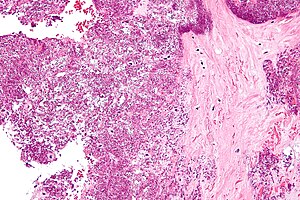Chondrocalcinosis
| Calcium pyrophosphate dihydrate disease | |
|---|---|
 |
|
| Micrograph showing crystal deposition in an intervertebral disc. H&E stain. | |
| Classification and external resources | |
| Specialty | rheumatology |
| ICD-10 | M11.1-M11.2 |
| ICD-9-CM | [712.3 275.49 [712.3]] |
| OMIM | 600668 118600 |
| DiseasesDB | 10832 DDB 30784 |
| MedlinePlus | 000421 |
| eMedicine | med/1938 radio/125 orthoped/382 emerg/221 |
| Patient UK | Chondrocalcinosis |
| MeSH | D002805 |
Calcium pyrophosphate dihydrate (CPPD) crystal deposition disease, also known as pseudogout and pyrophosphate arthropathy is a rheumatologic disorder with varied symptoms and signs arising from the accumulation of crystals of calcium pyrophosphate dihydrate in the connective tissues. The alternative names emphasize particular aspects of the clinical or radiographic findings. The knee joint is the most commonly affected.
Calcium pyrophosphate dihydrate crystals are associated with a range of clinical syndromes, which have been given various names, based upon which clinical symptoms or radiographic findings are most prominent. A task force of the European League Against Rheumatism (EULAR) made recommendations on preferred terminology. Accordingly, calcium pyrophosphate deposition (CPPD) is an umbrella term for the various clinical subsets, whose naming reflects an emphasis on particular features. For example, pseudogout refers to the acute symptoms of joint inflammation or synovitis: red, tender, and swollen joints that may resemble gouty arthritis (a similar condition in which monosodium urate crystals are deposited within the joints). Chondrocalcinosis, on the other hand, refers to the radiographic evidence of calcification in hyaline and/or fibrocartilage. "Osteoarthritis (OA) with CPPD" reflects a situation where osteoarthritis features are the most apparent. Pyrophosphate arthropathy is a term that can refer to several of these situations.
The exact cause of CPPD is unknown, although increased breakdown of adenosine triphosphate (ATP; the molecule used as energy currency in all living things), which results in increased pyrophosphate levels in joints, is thought to be one reason why crystals may develop.
Familial forms are rare. One genetic study found an association between chondrocalcinosis and a region of chromosome 8q.
...
Wikipedia
